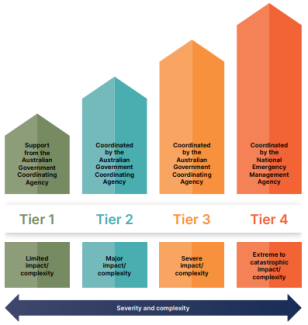National plans
Australia is affected by a variety of hazards every year, ranging in scale, complexity and impact. The impacts of natural hazards, such as tropical cyclones, bushfires, earthquakes and disease outbreaks may cause a crisis. Human-induced hazards, such as cyber-attacks, may also result in a crisis.
To help governments understand and respond to these challenges, there are a number of Australian Government National Response Plans (National Plans).
Natural hazards and space weather
We're the Australian Government's Coordinating Agency for natural hazards and space weather. We coordinate the Australian government's response to crises caused by these hazards. Our support could include sending a firefighting aircraft to a State needing additional resources to fight bushfires.
We maintain the following National Plans for natural hazards and space weather:
- Australian Government Disaster Response Plan (COMDISPLAN).
- Australian Government Space Re-Entry Debris Plan (AUSSPREDPLAN).
Domestic components of international crises
The Department of Foreign Affairs and Trade is the Australian Government Coordinating Agency for crises occurring overseas. While we’re the Sector Lead Agency for coordinating the domestic components of these crises. For example, during an international crisis, we may coordinate domestic support that Australia would deploy to a country in need. This could include deploying doctors or trained urban search and rescue personnel overseas to provide support to a country after an earthquake.
We own and maintain the following National Plans for international crises:
- Australian Government Overseas Assistance Plan (AUSASSISTPLAN).
- Australian Government Plan for the Reception of Australian Citizens and Approved Foreign Nationals Evacuated from Overseas (AUSRECEPLAN).
- Australian Government Response Plan for Overseas Mass Casualty Incidents (OSMASSCASPLAN).
Tier 4 crises and novel hazards
We are the Australian Government Coordinating Agency for Tier 4 and novel crises. In the AGCMF’s four-tier crisis model, a Tier 4 crisis is the most significant crisis and can be caused by any hazard. A novel, or ambiguous, hazard is one that’s not been anticipated, and can’t be responded to using any existing National Plans. If a novel hazard would cause a crisis, we will be the Australian Government Coordinating Agency until a more appropriate agency is identified.

